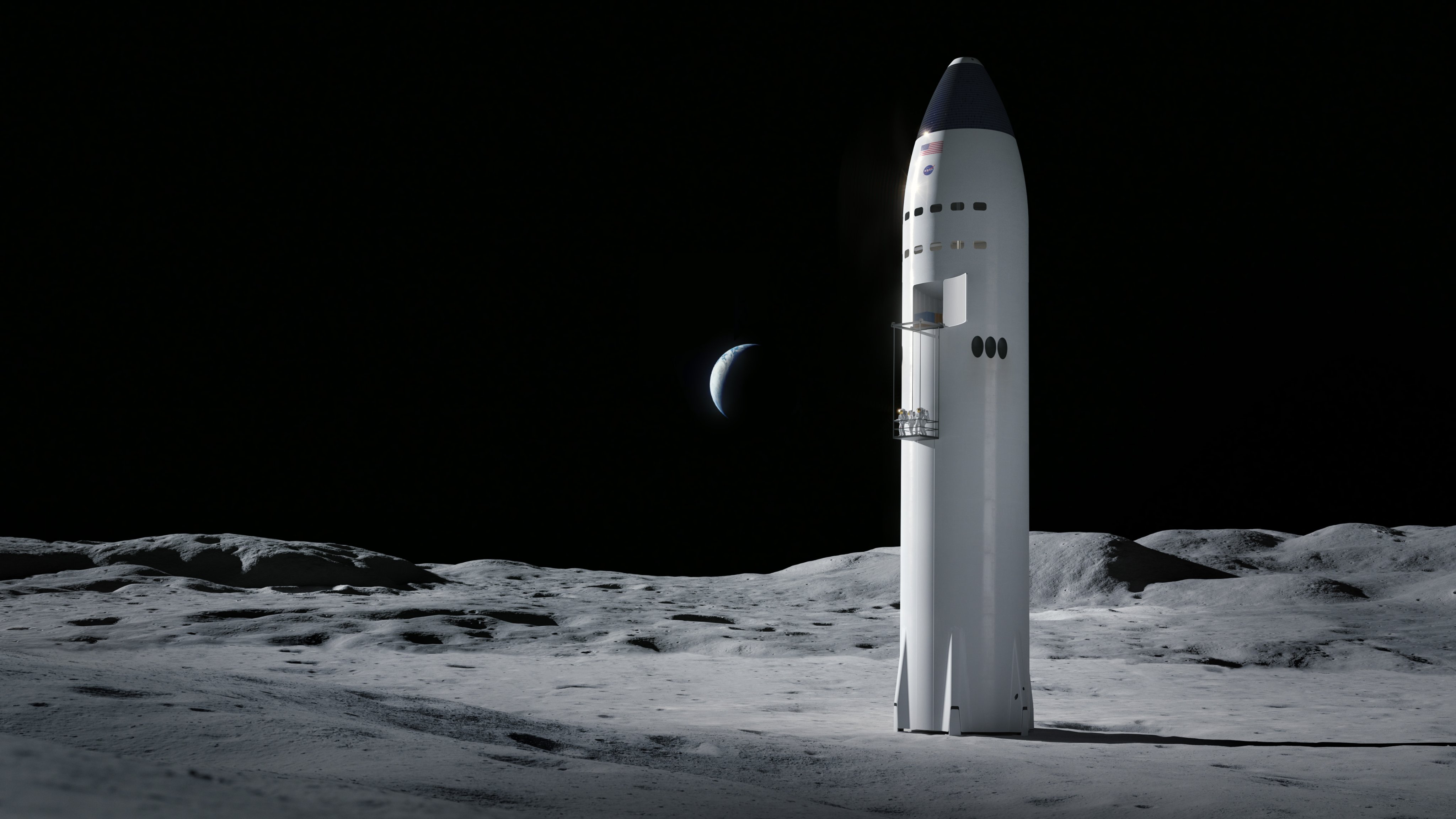NASA awards Artemis Moon lander contracts to Dynetics, SpaceX, and National Team

APR. 30, 2020–In a teleconference this morning, NASA announced the winners of the Human Lander System contracts for the Artemis missions. The three winners were:
- Dynetics of Huntsville, Alabama, proposing the Dynetics Human Lander System.
- SpaceX of Hawthorne, California, proposing the Lunar Starship.
- The National Team, headed by Blue Origin of Kent, Washington, and supported by Lockheed Martin, Northrop Grumman, and Draper, proposing the Integrated Lander Vehicle (ILV).
A total of $967 million was awarded to the competitors, with $579 million going to the National Team, $253 million going to Dynetics, and $135 million to SpaceX. This is the first time contracts have been awarded for lunar landers since the design studies of the Altair lander for the now-canceled Constellation program in 2009.
Outlining the current lander concepts, in alphabetical order…
Blue Origin National Team – Integrated Lander Vehicle

The National Team’s lander, the Integrated Lander Vehicle (ILV) is a three-stage lander, flying on United Launch Alliance’s Vulcan rocket. From bottom to top are the Transfer Stage, Descent Stage, and the Ascent stage. The three stages interacting together are visible in the following video, supplied by Blue Origin:
In detail:

ILV Transfer Stage – Northrop Grumman
The ILV’s transfer stage is a Cygnus-derived stage meant to take the ILV from the insertion orbit provided by ULA’s Vulcan rocket to a final, low lunar orbit. The Transfer stage is developed by Northrop Grumman, and sits on the bottom of the three-stage stack.

Descent Stage – Blue Origin
The Descent stage is derived from Blue Origin’s Blue Moon concept. It features dual BE-7 hydrolox engines, which are 3D printed and generate 40 kN of thrust each. The Descent stage sits in the middle of the stack, and will power the vehicle from a low lunar orbit to a soft landing on the lunar surface.

Ascent Stage – Lockheed Martin
Lockheed Martin, along with leading crewed flight operations and training, is developing the reusable Ascent stage. The Ascent stage also contains the crew cabin, which has “significant commonality with Orion”, according to NASA. The Ascent stage powers the stage from lunar takeoff to docking.
Draper will develop the guidance, navigation, and control (GNC) systems for the ILV. Draper is the same group that originally developed the Apollo guidance computer, 50 years ago. The ILV will be able to dock with either Orion immediately or the Gateway to await crew arrival. The individual stages can be launched on rockets such as Vulcan and New Glenn, or they can be launched as a whole stack onboard the Space Launch System (SLS) rocket. The National Team is targeting a 2023 first test of the ILV.
Dynetics – Human Landing System

Dynetics has proposed the Dynetics Human Landing System for the HLS contract. Being rated the highest technically by NASA, Dynetics has a single state solution for crew landing and return. The crew section is also built in a way that easily facilitates crew movement, slung very low to the ground. The entire vehicle can launch on any lifter, fly under its own power or launcher power to Gateway, receive a fuel top-off if necessary, and land. After an expedition, it can take off, and dock back to Orion or Gateway. The vehicle does employ drop tanks – and it will drop its tanks on ascent as they empty.
SpaceX – Lunar Starship

The Lunar Starship is a Moon-oriented Starship variant that is fully reusable in-space, using six Raptor engines and including two airlocks and a spacious cabin. This Lunar Starship will be fueled by a tanker in low Earth orbit, and then proceed to Gateway. From Gateway, it will land on the Moon, using its Raptor engines for descent and then unnamed thrusters near the top for final landing.
However, SpaceX received the worst rating (earning merely “Acceptable” technically and management-wise) by the NASA Source Evaluation Panel. They also received the least amount of money – $135 million. On the other side, Starship is by far the most capable and sustainable vehicle proposed for the Human Lander System contract. It is able to transport over 100 tons to the lunar surface, far greater than any other proposal.
NASA will probably have to downselect from the three winners in 2021, ten months from today. We are not entirely sure yet, and they may choose to keep all three landers. Until further announcement, it’s anybody’s guess as to what landers will stay, and which will be the first to land on the Moon on Artemis 3.
Fifty years ago, the Apollo program proved it was possible to safely land humans on the moon and return them safely to Earth, even in the face of adversity. In four years, when the Artemis program returns to the Moon, it will go in a way NASA says “reflects the world today — with government, industry, and international partners in a global effort.”
With the current bipartisan support for a moon landing within the first five years of this decade, we shall return to the moon and do the other things, like going to Mars. Not because they are easy, but because they are hard. And even if it’s 50 years late, it’s better late than never.



